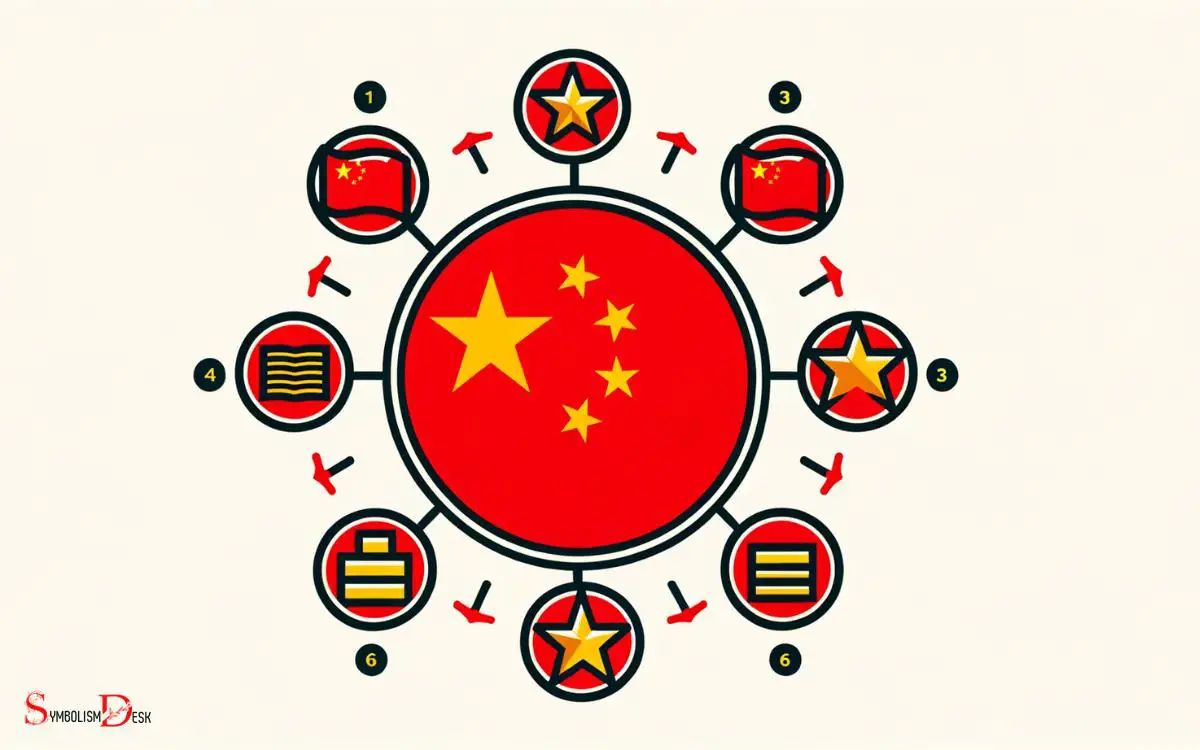What Do the Symbols on the Chinese Flag Mean? Unity!
The five stars on the Chinese flag symbolize the unity of the Chinese people under the leadership of the Chinese Communist Party (CCP).
The large star represents the CCP, while the four smaller stars represent the four social classes – the working class, the peasantry, the urban petite bourgeoisie, and the national bourgeoisie.
The design of the Chinese flag was selected in 1949, when the People’s Republic of China was established. The flag’s red backdrop is said to represent the revolution and the blood of those who died during the civil war and the Sino-Japanese war.
The stars are a depiction of unity among the Chinese people and the leading role of the Communist Party.
Key Takeaway

5 Symbolic Meaning of the Chinese Flag
| Symbol | Meaning |
|---|---|
| Large Gold Star | Represents the Communist Party of China, the ruling party in China |
| Four smaller Stars | Represents the four social classes as per the Chinese constitution – the working class, the peasantry, the urban petty bourgeoisie and the national bourgeoisie |
| The color Red | Symbolizes the revolution and the communist revolution |
| The color Yellow (of the stars) | The golden color symbolizes the golden brilliant rays radiating from the vast red land |
| The Position of the stars | The pattern of stars symbolize the unity of the Chinese people under the leadership of the Communist Party of China. |
Historical Evolution of the Flag
The historical evolution of the Chinese flag reflects significant political and cultural changes in the country’s history.
The first national flag, used from 1889 to 1912, during the Qing dynasty’s downfall, featured a dragon and a sun, symbolizing imperial power and the nation.
After the establishment of the Republic of China in 1912, the five-striped flag became the national symbol, representing the union of the five major ethnic groups.
The flag underwent further changes under the Communist Party’s rule, with the current design adopted in 1949.
The large golden star represents the Communist Party’s leadership, while the four smaller stars symbolize the working class, peasantry, urban petty bourgeoisie, and national bourgeoisie.
Understanding the historical context behind these flag changes provides insight into China’s political and cultural transformations.
The Red Background
Depicting the red background on the Chinese flag holds significant political and historical symbolism.
- Revolutionary Struggle: The red background symbolizes the communist revolution led by the Communist Party of China, representing the bloodshed and sacrifices made in the struggle for independence and liberation.
- The Communist Party: The red background pays homage to the Communist Party, signifying its leadership and the establishment of the People’s Republic of China.
- The Chinese People: The red background also represents the Chinese people’s spirit, resilience, and the unity of the nation under the leadership of the Communist Party. It serves as a constant reminder of the sacrifices.
Significance of the Golden Stars
Representing the unity of the Chinese people, the golden stars on the Chinese flag hold symbolic significance. The large star on the hoist side represents the leadership of the Communist Party of China.
The four smaller stars surrounding it symbolize the four social classes: the working class, the peasantry, the urban petite bourgeoisie, and the national bourgeoisie, all united under the leadership of the Communist Party.
This symbolism reflects the unity and cooperation of the Chinese people under the guidance of the Communist Party.
The golden color of the stars represents the bright prospects of the socialist state and the Chinese people. Altogether, the golden stars on the Chinese flag convey the message of unity, cooperation, and the promising future of the nation.
| Symbol | Representation |
|---|---|
| Large Star | Leadership of the Communist Party of China |
| Four Smaller Stars | Four social classes: working class, peasantry, urban petite bourgeoisie, and national bourgeoisie |
| Golden Color | Bright prospects of the socialist state and the Chinese people |
Symbolism of the Colors
The colors on the Chinese flag hold deep symbolism. Red represents the revolutionary spirit and the bloodshed of those who fought for the nation’s freedom. Yellow, on the other hand, signifies the Chinese ethnicity and the historical dominance of the Han people.
Understanding the significance of these colors provides insight into the rich cultural and historical tapestry of China.
Red: Revolutionary Spirit
The color red on the Chinese flag conveys the revolutionary spirit that emerged during the country’s struggle for independence and transformation.
This vibrant hue holds deep symbolism, representing several key aspects of China’s history and identity:
- Revolutionary Struggle: The red on the flag reflects the revolutionary spirit of the Communist Party and the numerous uprisings and movements that have shaped modern China.
- Sacrifice and Bloodshed: It signifies the sacrifices made by countless individuals who fought for the nation’s freedom and the bloodshed endured during times of conflict and change.
- Strength and Power: Red also symbolizes the strength and power of the Chinese people, showcasing their resilience and determination in the face of adversity.
The color red serves as a powerful reminder of China’s tumultuous past and its unwavering commitment to progress and transformation.
Yellow: Chinese Ethnicity
Symbolizing the ethnicity of the Chinese people, the color yellow on the flag continues to reflect their historical identity and cultural heritage. Yellow has been historically revered in China and is often associated with the legendary Yellow Emperor, a cultural and ancestral figure in Chinese mythology.
The color represents the traditional Han Chinese ethnicity, which is the predominant ethnic group in China, comprising over 90% of the population.
Cultural and Political Interpretations
The symbols on the Chinese flag hold deep cultural and political significance, representing the nation’s rich history and values. Understanding the symbolism in the flag requires an exploration of the historical context and the enduring meaning behind each symbol.
Symbolism in Flag
With its distinct design and colors, the Chinese flag embodies a rich array of cultural and political symbolism. The symbolism in the flag reflects the deep-rooted traditions and values of Chinese culture, as well as the ideals and aspirations of the Chinese people.
Here are three key aspects of the symbolism in the Chinese flag:
- Color Symbolism: The red color represents the communist revolution and the bloodshed of the martyrs, while the five golden stars symbolize the unity of the Chinese people under the leadership of the Communist Party.
- Historical Significance: The large golden star represents the Communist Party of China, while the four smaller stars symbolize the four social classes as defined in Mao Zedong’s theory.
- Cultural Heritage: The design of the flag draws inspiration from traditional Chinese symbols, reflecting the country’s rich cultural heritage and history.
Historical Significance of Symbols
The symbols on the Chinese flag hold immense historical significance, representing thousands of years of Chinese culture and political evolution.
The red background symbolizes the revolutionary heritage of the country, reflecting the communist ideology and the bloodshed of those who fought for the nation’s independence.
The large golden star represents the leadership of the Communist Party of China, while the four smaller stars embody the four social classes of the nation working together under the leadership of the Communist Party.
From a cultural perspective, the flag’s symbolism reflects the profound impact of China’s history and political ideology on its national identity.
Understanding the historical significance of these symbols provides insight into China’s rich cultural and political heritage. Understanding the historical significance of these symbols provides insight into China’s rich cultural and political heritage. These symbols often carry deep-rooted meanings that reflect core values such as harmony, perseverance, and unity. For instance, learning to write your name in Chinese not only bridges linguistic gaps but also offers a glimpse into the artistry and philosophical depth embedded in Chinese calligraphy. By engaging with these traditions, one can develop a deeper appreciation for the enduring legacy of one of the world’s oldest civilizations.
This historical significance has had a profound impact on the global recognition of China, shaping its interactions with the international community and fostering a deeper understanding of its cultural and political values.
Do the Symbols on the Korean Flag Represent Unity as Well?
The symbols on the korean flag carry significant meaning, representing more than just unity. The flag, known as the Taegeukgi, features a red and blue yin and yang symbol within a background divided into four sections. These symbols on the Korean flag embody the concept of balance, harmony, and the unification of opposing forces, emphasizing unity in all aspects of Korea’s history and culture.
Do the Symbols on the Chinese Flag Also Represent Unity?
The meaning of symbols on PNG flag portrays the country’s unity. Similarly, on the Chinese flag, the symbols also represent unity. The large gold star symbolizes the Communist Party, while the four smaller stars signify the unity of Chinese people under the leadership. These symbols emphasize cohesion and harmony within the nation. The flag of Japan also utilizes symbols to convey meaning. The red circle in the center of the white flag, known as the “Nisshōki,” represents the sun and symbolizes the nation of Japan. Similarly, the symbols on flags serve as visual representations of a country’s history, values, and ideals. In this context, the symbol interpretation explained holds significant cultural and historical importance.
Global Impact and Recognition
China’s flag symbols have achieved global recognition and impact. This recognition is evident in various ways:
- International Relations: The Chinese flag, with its distinct symbols, is used as a diplomatic tool, representing the country in international forums and events.
- Cultural Significance: The symbols on the Chinese flag have become a globally recognized representation of Chinese culture and heritage, influencing the perception of China on the world stage.
- Trade and Commerce: The flag’s symbols have an impact on global trade and commerce, as they are associated with Chinese products and businesses, contributing to the country’s economic influence.
The recognition and impact of the symbols on the Chinese flag have transcended national boundaries, playing a significant role in shaping China’s global image and relationships.
Conclusion
In conclusion, the symbols on the Chinese flag have evolved over time to reflect the country’s history, culture, and political ideology.
The red background symbolizes the revolution, while the golden stars represent the unity of the Chinese people under the leadership of the Communist Party.
The colors of the flag hold deep cultural and political significance, and the flag’s global recognition reflects China’s growing influence on the world stage.






